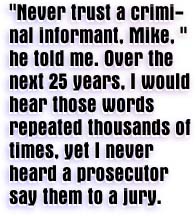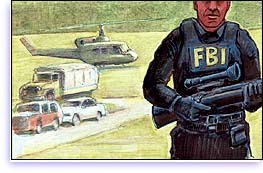


he Senate hearings into the killing of the wife and child of Randy Weaver by FBI sharpshooters themselves ignored the root cause of the whole incident — a problem that should concern every American, at least as much as the O.J. verdict — the illegal use of criminal informants by federal law enforcement. The following story will illustrate exactly what I mean.
 In the fall of 1966, at the beginning of my 25-year career in federal law enforcement, while serving in the agency now known as the Bureau of Alcohol, Tobacco and Firearms, I received a visit from “Ray,” a convicted drug dealer and petty thief with a glass eye and a missing front tooth, one of our army of CIs — paid criminal informants.
In the fall of 1966, at the beginning of my 25-year career in federal law enforcement, while serving in the agency now known as the Bureau of Alcohol, Tobacco and Firearms, I received a visit from “Ray,” a convicted drug dealer and petty thief with a glass eye and a missing front tooth, one of our army of CIs — paid criminal informants.
“I met this guy who wanted to sell me a sawed-off shotgun for 60 bucks,” said Ray. “His name is Angel. He’s a black Puerto Rican.” He flashed me his goal post smile. “One of them Young Lords,” he added.
“How do you know it’s a violation?” I asked. A shotgun cut to a barrel length of less than 18 inches was a violation of the National Firearms Act, a federal felony — the law we enforced.
Ray winked his good eye at me. He knew the law as well as any agent, better than most. He made a living selling drug and gun cases to the government.
 “When the dude went out of the room to the john, I measured it with a piece of string — it was 17 1/2 inches.”
“When the dude went out of the room to the john, I measured it with a piece of string — it was 17 1/2 inches.”
“You’re sure?”
“Check it yourself,” he said, pulling out a length of string from his pocket.
I did. The string measured exactly 17 1/2 inches. Ray’d been as prepared as an Eagle Scout.
“How much is it worth if I duke you into the guy?” asked Ray.
I explained that if Angel delivered the gun in a car, we would seize it and the “informant fee” would be raised according to the value of the car. If Angel turned out to be a known criminal or someone famous, that would put the case in a “high profile” category, also raising the bounty. But Angel Nobody with one gun was only worth $100, then twice the average weekly income in the U.S.
Ray already knew all this. He’d been a professional stool for years, shopping cases to all the federal agencies. Like all pros, he just wanted the arrangement spelled out beforehand. If I didn’t take the case he knew he might still be able to sell it to the FBI or another ATF agent.
Following my instructions, Ray set up a buy/bust meet. Later that night, covered by a team of about a half-dozen undercover agents, I met Angel, a nervous 18-year-old, on Bruckner Boulevard in the South Bronx. The kid had the gun in a paper bag just the way Ray said he would. I handed him the 60 bucks, took the gun and busted him.
On the way back to headquarters in lower Manhattan, Angel sat in stunned silence, handcuffed to a U bolt in the rear seat of my car. I questioned him hard about Ray, pretending that I wanted to arrest him, too — Who is Ray? Where did you meet Ray? Help me bust Ray and I’ll go easy on you — a routine scam used to protect the identity of a snitch. It worked. Angel kept his mouth shut, sticking to the code of the street, which meant that he had no idea Ray had set him up.
But then a few things happened that Ray didn’t count on. When I told Angel that possession and sale of a sawed-off shotgun carried a sentence of 25 years in federal prison, he blinked a couple of times and went to pieces. Crying, cursing himself as a rat, he told me everything about his new “friend” Ray.
Angel, who said he’d been looking for a job for the past six months, claimed that he’d met Ray on an unemployment line a few days earlier. Ray told him he knew a “sucker” who’d pay 60 bucks for an old, used shotgun selling for 10 in a pawn shop, if the barrel was cut down. Ray offered to put up the 10 bucks if Angel would cut the barrel off and deliver the gun. They’d split the profit — 25 bucks each. When they bought the gun, Ray even used a piece of string to mark exactly where it should be cut.
What Angel had described, without realizing it, was a clear-cut case of Informant Entrapment. A crime had only been committed because an agent of the U.S. government — a paid criminal informant — had provoked it.
 It must have been 2 a.m. when I lodged Angel in the Federal House of Detention. He was scared half to death. It was the first night he’d ever spent in jail. There was no way I could sleep. I went right to work. It took me two days to corroborate Angel’s version of events and get the charges dropped. Then I did all I could to take away Ray’s bounty hunter license. I wrote a report of the incident that would be obtainable by the defense attorneys in any case he was ever involved in. I hoped it would follow him for the rest of his miserable life.
It must have been 2 a.m. when I lodged Angel in the Federal House of Detention. He was scared half to death. It was the first night he’d ever spent in jail. There was no way I could sleep. I went right to work. It took me two days to corroborate Angel’s version of events and get the charges dropped. Then I did all I could to take away Ray’s bounty hunter license. I wrote a report of the incident that would be obtainable by the defense attorneys in any case he was ever involved in. I hoped it would follow him for the rest of his miserable life.
When I told the federal prosecutor, he thanked me. “Never trust a criminal informant, Mike,” he told me. Over the next 25 years, I would hear those words repeated thousands of times, by agents, cops, training instructors and prosecutors, yet I never heard a prosecutor say them to a jury. Most of us turned a blind eye to this paradox, or hypocrisy (depending on your point of view), because we made sure that by the time a case based on a CI’s testimony got to a jury trial, the CI’s words and actions had been corroborated by the most intensive and complete investigation possible. If you couldn’t corroborate a CI’s word, you dropped the investigation.
Everyone who’s ever carried a federal badge knows how easy it is to convict someone who’s been entrapped on little more than an informant’s testimony, as long as the informant was clever enough to hide his tracks, the victim gullible enough to fall for the trap and the agents and prosecutors ambitious enough to go for the headlines and win at any price. Until recently, I believed most of us in federal law enforcement were people whose consciences would not allow that to happen. I’m no longer so sure.
After the Angel-Ray case, I continued on with the ATF for three more years before transferring into narcotic enforcement. During those years I never saw another case of possession and sale of a sawed-off shotgun, involving a CI, accepted by the federal courts in New York. There was too much possibility of Informant Entrapment.
So, 25 years later, when I heard that the case that led to the killing by FBI sharpshooters of Randy Weaver’s young boy and unarmed wife as she carried his baby had begun with Weaver being charged with “possession of a sawed-off shotgun” by the ATF, and that he had subsequently been found Not Guilty by reason of Informant Entrapment, I wondered: Who allowed this kind of case to reach arrest and trial in the first place, and why? If some politician or bureaucrat doesn’t like the way you exercise your rights as a citizen, can he now target you with the government’s legion of belly-crawlers?
Now, during a time when our federal agencies rely on criminal informants for more than 95 percent of their drug and weapons cases, is anyone minding the CI store? One of the vital concerns of our elected leaders should be: Whatever happened to those people of conscience in the Weaver case? That our government settled with Mr. Weaver for $3.1 million in damages and not a single federal agent was even questioned about this aspect of the case seems to say it all, doesn’t it?
Michael Levine is a 25-year veteran of federal law enforcement and the author of Deep Cover and The Big White Lie.

